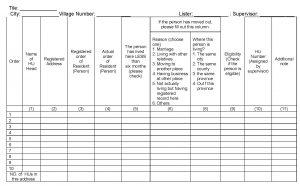- Home
- About Us
- Chapters
- Study Design and Organizational Structure
- Study Management
- Tenders, Bids, and Contracts
- Sample Design
- Questionnaire Design
- Instrument Technical Design
- Translation
- Adaptation
- Pretesting
- Interviewer Recruitment, Selection, and Training
- Data Collection
- Paradata and Other Auxiliary Data
- Data Harmonization
- Data Processing and Statistical Adjustment
- Data Dissemination
- Statistical Analysis
- Survey Quality
- Ethical Considerations
- Resources
- How to Cite
- Help


Appendix B (Administration of the Within-Housing-Unit Listing of Eligible Persons)
- Identify the eligibility of the selected housing units (HUs) by listing the eligible persons within each selected HU (list of household members).
- Choose an HU residency rule to identify eligible respondents within each HU. Similar to defining a target population, once the rule is defined, it should be consistent across all participating countries. Choose between:
- De facto residence rule–persons who slept in the HU the previous night.
- Advantage: Easy to remember.
- De jure residence rule–persons who 'usually' sleep in HU.
- Advantage: A better representation of the typical residents of a HU.
- Design a household enumeration table based on study-specific residence rules and goals.
- De facto residence rule–persons who slept in the HU the previous night.
- Motivated misreporting (deliberate concealment): household reporters deliberately conceal members for a multitude of reasons, including fear that they or another member may be evicted or deported.
- Poor fit between living situation and definition: membership is complex and shows that household members may have confusion or disagree about who is a member.
Example 1 of a within-household listing table:
| HOUSEHOLD LISTING | RESPONDENT SELECTION | |||||||
|
11 a. Household Member’s First Name |
11 b. Household Member’s Relationship to Informant |
11 c. Sex |
11 d. Year of Birth |
11 e. Language Spoken |
11 f. Eligible |
11 g. Person Number |
11 h. Selected R |
|
| M A L E S | M | |||||||
| M | ||||||||
| M | ||||||||
| M | ||||||||
| M | ||||||||
| M | ||||||||
| M | ||||||||
|
F E M A L E S |
F | |||||||
| F | ||||||||
| F | ||||||||
| F | ||||||||
| F | ||||||||
| F | ||||||||
| F | ||||||||
- Column 11a (Household Member’s First Name): List all members of the household, beginning with the informant.
- Column 11b (Household Member’s Relationship to Informant): Record each household member’s relationship to the informant (e.g., husband or wife, son or daughter, mother or father, brother or sister, friend, etc.).
- Column 11d (Age): Record each household member’s age.
- Column 11e (Language Spoken): This column may or may not be included, depending upon the study requirements.
- Column 11f (Eligible): Place a check mark in this column if, based upon the information in columns 11a-11e, the household member meets the eligibility criteria for the study.
- Column 11g (Person Number): Assign a sequential number to each eligible household member.
- Column 11h (Selected R): Count the number of eligible persons in the household. Find that number in the Kish table in the “If the Number of Eligible Persons is:” column. The selected respondent will be the household member with the “Person Number” corresponding to the “Interview the Person Numbered:” column in the Kish table (For more information about Kish tables, see Data Collection: Face-to-Face Surveys).
Example 2 is the [zotpressInText item="{2265844:VYBJMD3V}" format="%a% (%d%)"] enumeration table:
This study found the main challenge of listing to be situations where urban and rural villages were adjacent to one another. These situations contained complicated building structures and mixed populations (part-time and nonresident population). Therefore, the table specifically documents when more than one HU was located within a single dwelling, the reason the registered person had moved out, the time when the registered person moved out, and where the registered person had moved.
References
[zotpressInTextBib style="apa" sortby="author"]